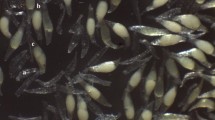Abstract
The percentage of ovules developing into seeds (seed-ovule ratios, S/O ratios) is about 85% in annuals but only approximately 50% in perennials.In both annuals and perennials, these typical S/O ratios occur regardless of the kind of breeding system, although many annuals are normally self-pollinating whereas perennials are virtually all cross-pollinating. The mean number of seeds maturing within individual fruits is defined as brood size, and is correlated with different modes of dispersal and strategies of ovule packging. Annuals also have significantly higher brood sizes (21.7) than perennials (<9.9). Among perennials, woody plants have both lower S/O ratios (32.7%) and brood sizes (3.3) than herbaceous perennials (57.2%, 13.5). S/O ratios appear to be largely determined genetically, whereas resource limitations are perhaps more critical in terms of regulating flower production. Among perennials, increased exposure to predators and pathogens is suggested as the best explanation for theevolution of breeding systems favoring genetic recombination. The maintenance of genetic polymorphisms, however, inevitably increases the frequency of lethal and sub-lethal allelic combinations (and perhaps mutations?), that appear to be responsible for the lower S/O ratios in perennials.
Similar content being viewed by others
References
Allard RW, Jain SK (1962) Population studies in predominantly self-pollinated species. II. Analysis of quantitative genetic changes in a bulk-hybrid population of barley. Evolution 16:90–101
Apirion D, Zohary D (1961) Chlorophyll lethals in natural populations of orchard grass (Dactylis glomerata L.): a case of balanced polymorphism in plants. Genetics 46:393–399
Arnow L, Albee B, Wycoff A (1980) Flora of the central Wasatch Front Utah. Museum of Natural History, University of Utah, Salt Lake City
Bennett MD (1972) Nuclear DNA content and minimum generation time in herbaceous plants. Proc R Soc Lond B 181:109–135
Bertin RI (1982) Paternity and fruit production in trumpet creeper (Campsis radicans).Am Nat 119:694–709
Biggers JD (1981) In vitro fertilization and embryo transfer in human beings. New Engl J Med 304:336–342
Bostock SJ, Benton RA (1979) The reproductive strategies of five perennial compositae. J Ecology 67:91–107
Brambell FWR (1948) Prenatal mortality in mammals. Biol Rev 23:370–407
Brink RA, Cooper DC (1947) The endosperm in seed development. Bot Rev 13:423–477
Casper BB (1983) The efficiency of pollen transfer and rates of embryo initiation. Oecologia (Berl) 59:262–268
Casper BB, Wiens D (1981) Fixed rates of random ovule abortion in Cryptantha flava (Boraginaceae) and its possible relation to seed dispersal. Ecology 62:866–869
Charnov E (1979) Simultaneous hermaphroditism and sexual selection. Proc Nat Acad Sci USA 76:2480–2484
Chinnappa CC, Morton JK (1984) Studies on the Stellaria longipes complex (Caryophyllaceae) — Biosytematics. Systematic Bot 9:95–101
Cruden RW (1972) Pollinators in high elevation ecosystems: relative effectiveness of birds and bees. Science 176:1439–1440
Darwin C (1876) The effects of cross-and self-fertilization in the vegetable kingdom. John Murray, London
Feeney P (1976) Plant apparency and chemical defense. In: Wallace J. Mansell R (eds) Biochemical interactions between plants and insects. Rec Adv Biochem 10:1–40
Gillett JB (1962) Pest pressure, an underestimated factor in evolution. Syst Assoc Publ 4:37–46
Grant V (1975) Genetics of flowering plants. Columbia Univ Press, New York
Grant V (1982) Periodicities in the chromosome numbers of angiosperms. Bot Gaz 143:379–389
Grant V, Flake RH (1974) Solution to the cost-of-selection dilemma. Proc NatAcad Sci USA 71:3865–3865
Haldane JBS (1957) The cost of natural selection. J Genetics 55:511–524
Hamrick JL (1979) Genetic variation and longevity. In: Solbrig OT, Jain S, Johnson GB, Raven PH (eds) Topics in plant population biology. Columbia Univ Press, New York, pp 89–107
Harper JL (1977) Population biology of plants. Academic Press, London
Herbert SJ (1979) Density studies on lupines. II. Components of seed yield. Ann Bot 43:65–73
Janzen D (1977) A note on optimal mate selection in plants. Am Nat 11:365–371
Johnson MP, Cook SA (1968) “Clutch size” in buttercups. Am Nat 102:405–411
Lee TD, Bazzaz FA (1982) Regulation of fruit and seed production in an annual legume, Cassia fasciculata. Ecology 63:1363–1373
Levin D (1975) Pest pressure and recombination systems in plants. Am Nat 109:437–452
Levin DA, Turner BL (1978) Clutch size in Compositae. In: Stonehouse BD, Perrins CM (eds) Evolutionary ecology, Univ Park Press, Baltimore, pp 215–222
May RM (1978) Clutch size in plants. Nature 276:671–672
Munz PA (1974) A flora of southern California. Univ Calif Press, Berkeley
Nittancourt D de (1977) Incompatibility in angiosperms. Springer, New York
Ornduff R (1969) Reproductive biology in relation to systematics. Taxon 18:121–133
Renner O (1917) Versuche über die gametische Konstitution der Oenotheren. Z Bot 13:609–621
Salisbury EJ (1942) Reproductive capacity of plants. Bell Co, London
Schemske DW (1983)Breeding systems and habitat effects on fitness components in three neotropical Costus (Zingiberaceae). Evolution 37:523–539
Stephenson AJ (1981) Flower and fruit abortion: proximate causes and ultimate functions. Ann Rev Ecol Syst 12:253–279
Volpe EP (1981) Understanding evolution. 4th ed, Wm C Brown Co, Dubuque
Westoby M, Rice B (1982) Evolution of the seed plants and inclusive fitness of plant tissues. Evolution 36:713–728
Willson MF (1983) Plant reproductive ecology. Wiley and Sons, New York
Wyatt R (1981) Components of reproductive fitness in five tropical legumes. Bull Torrey Bot Club 108:67–75
Author information
Authors and Affiliations
Rights and permissions
About this article
Cite this article
Wiens, D. Ovule survivorship, brood size, life history, breeding systems,and reproductive success in plants. Oecologia 64, 47–53 (1984). https://doi.org/10.1007/BF00377542
Received:
Issue Date:
DOI: https://doi.org/10.1007/BF00377542




